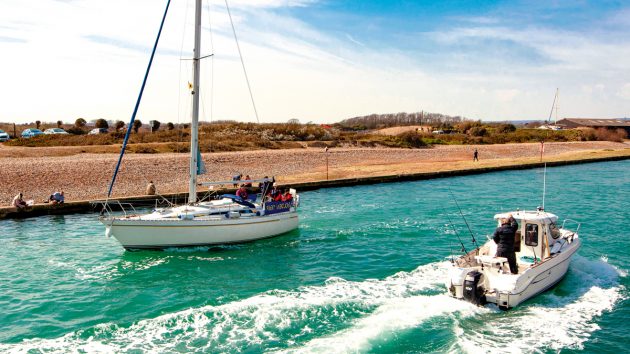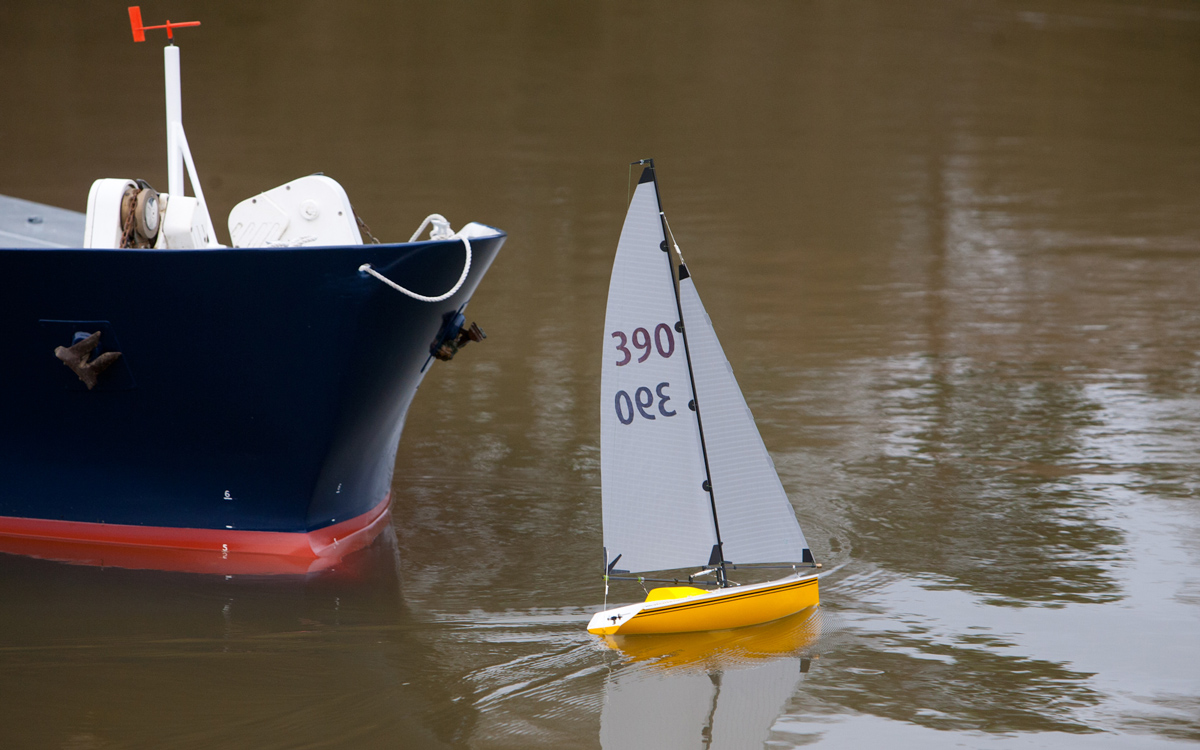Andy Du Port draws upon more than 50 years’ sailing experience to discuss boat etiquette under way…
The actions we take to avoid collisions at sea are set out in the Colregs, which we must obey, and nothing which follows should be taken in any way to override them or the requirements of SOLAS or local regulations. How we interact with our fellow sailors while underway, though, is a combination of common sense, courtesy and etiquette.
Boat etiquette – ‘what most people do’ – is subjective and constantly changing, and my aim here is to share a few thoughts with you on such diverse subjects as fenders, overtaking, waving and avoiding embarrassing close encounters with ships.
Fenders
Having a fender dangling over the side when under way is very definitely not the thing to do. I don’t know why, but it has been that way from time immemorial.
Having a full set of boat fenders rigged is less heinous than just the one, perhaps, because a single fender must be a mistake whereas three or four could be for a good reason.
Article continues below…
Boat flag etiquette: Everything you need to know about ensigns and burgees
Almost everything we do, ashore and afloat, is governed by laws, which we must obey, and guidance, which we can…
ColRegs refresher – 12 videos every skipper should watch
Are you windward or leeward? Starboard or port? Do you know Rule 12(iii) and how do you cross a shipping…
By all means secure your fenders to the guard wires in good time, but keep them inboard until you make the final approach to your berth.
If you’re short-handed, they may need to be deployed slightly earlier; you don’t want your view obstructed by the crew scurrying about making last minute preparations.
When setting off, get the fenders inboard as soon as it is prudent to do so. They can be stowed away in slow time.

Poor boat etiquette? On the crowded Broads, the fenders could well be justified! Photo: Steve Rumford/Alamy
Ropes
Lines dangling over the side look sloppy and can be a real hazard if they become wrapped round the prop. So try to keep them out of the water at all times. Anyway, you really don’t want wet lines mouldering in the cockpit locker.
If you are tempted to point out someone’s errant fender you may not get the thanks you expect; if you indicate that a rope is in the water, though, you could prevent a disaster.
Friendly acknowledgement
Most people simply raise an arm in greeting to a passing yacht, and it is usual for just one member of the crew to do so – normally the helmsman. The whole crew madly waving may cause alarm or bemusement. Think royalty on the balcony of Buckingham Palace, not football fans celebrating the latest goal.

Mind your wash! Passing close ‘green to green’ is rarely sensible. Photo: Niki Hurrell-Head/Alamy
Overtaking boats
Obviously you will obey the Colregs when overtaking, but there is also an element of etiquette about how you do it:
- Sail overtaking sail: You’ll almost certainly be on the same tack but, in any case, you are the give way vessel. It is usually more considerate to overtake to leeward, raising an arm as you do so and trying not to look too smug about your boat’s superior sailing qualities! If you need to pass upwind, don’t pass so close that the other yacht loses her wind.
- Power overtaking sail: You’ll probably overtake quite quickly but, if practicable, you should pass to leeward for the reasons stated above. However, in this case, taking a yacht’s wind is not the main issue, but your wash may be. A small yacht sailing in a light breeze could come to a complete stop if confronted by even a moderate wash from ahead. From astern, it may help her on her way, but she’ll not thank you if you cause everyone to cling on for dear life as you steam past at 20 knots.
It’s customary at sea not to pass close ahead of another vessel if there is any chance of causing concern or confusion. Large ships in open waters will try to keep at least a mile clear of each other; between small craft, any closer than two or three boat lengths is probably too close. If a small alteration of course to pass thoughtfully astern is all it takes, it’s well worth the effort.
Giving way
When it comes to taking avoiding action absolute adherence to the Colregs won’t necessarily satisfy the requirements of boat etiquette. Your aim must be to avoid worrying the other skipper, so you’ll need to make it crystal clear by your movements alone that you have the matter in hand.
Although you’ve determined that you will pass safely astern of a crossing vessel, it may not be clear unless you make a significant alteration of course in plenty of time.
In a nutshell, the other skipper should never have to even think of invoking Rule 17 which allows the stand-on vessel to manoeuvre if in doubt that the give-way vessel is taking appropriate avoiding action. It may be perfectly safe to pass ahead, but only if you’re not going to cause palpitations in the other boat.
When a motor boat gives way to a sailing vessel, and allowing for the inevitable changes of speed through the water due to a variable wind, a considerate skipper will allow for a CPA (closest point of approach) of at least three to four boat lengths, preferably more.
As we all know, meeting nearly head-on when under power is fraught with danger as both boats should take action, and you should be very, very wary of altering course to port in such circumstances.
However, there are times when it is safe and sensible to do so if you do it boldly and in plenty of time. The acid test, as so often in matters of etiquette, is to put yourself in the shoes of the other skipper and ask: ‘Am I giving him any cause for anxiety by not sticking to the letter of the Colregs?’

Keep well clear of large ships. Photo: Patrick Eden/Alamy
Avoiding large ships
Now we come to the rather tricky interpretation of the Colregs when avoiding large ships. Again, boat etiquette demands that you don’t cause disquiet on the bridge.
On the other hand, you know perfectly well that the chances of a 400m, 200,000 ton container ship steaming down the Channel at 25 knots is unlikely to alter course to avoid a 10m yacht crossing at 5 knots.
She should but, let’s face it, she won’t. However, the Officer of the Watch (OOW) should still have your safety in mind – and he or she also has their sea-going career to consider. Don’t forget: ‘A collision at sea can ruin your entire afternoon’, as they say.
Assuming they haen’t seen you (don’t bet on it), they’d really prefer you keep out of their way whether you’re the stand-on vessel or not.
So, what to do? First, don’t pass ahead closer than at least a mile. If you do, you are quite likely to cause alarm on the bridge – exactly what we are trying to prevent – and even some angry blasts.
Net result: an irritated bridge team and a quaking yacht crew. Hardly in keeping with the principles of boat etiquette. The solution, of course, is to make a large and early alteration of course – probably at least 90° – to parallel the ship’s course until she is well clear.
With more and more small craft being fitted with AIS, there is an understandable temptation to identify and call the other ship on VHF to state your intentions. The Colregs have some clear guidance on this: don’t do it. If you do, there is always a chance that misunderstandings will occur or, at best, you’ll just irritate the OOW.
There are two other, very short, things to mention about boat etiquette under way.
Boat speed
Of course you will keep within any speed limit, but even 5 knots in a crowded river or anchorage – and certainly in a marina – will be too fast for the comfort and safety of others.
Always look astern and see what effect your wash is having on your fellow mariners; don’t hesitate to slow down if necessary.
Radio checks
One of the many reasons we go sailing is to enjoy some peace and quiet, and none of us wants our ears subjected to constant chatter on the radio. Most transmissions are entirely justified, but radio checks are not!
Resist the temptation to check your radio every time you set sail. If it is receiving clearly and was working last time you were out, it will almost certainly be working this time. If you suspect there is a fault, you should check it out – just avoid Ch16 like the plague. There are plenty of alternatives, notably the National Coastwatch Institution (NCI) on Ch65.
Why not subscribe today?
This feature appeared in the June 2022 edition of Practical Boat Owner. For more articles like this, including DIY, money-saving advice, great boat projects, expert tips and ways to improve your boat’s performance, take out a magazine subscription to Britain’s best-selling boating magazine.
Subscribe, or make a gift for someone else, and you’ll always save at least 30% compared to newsstand prices.
See the latest PBO subscription deals on magazinesdirect.com






